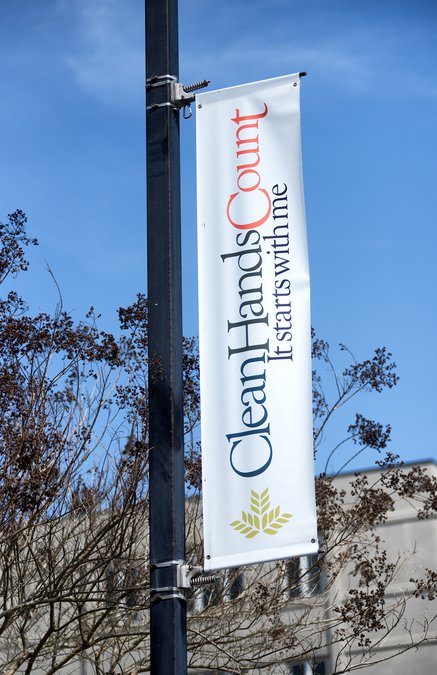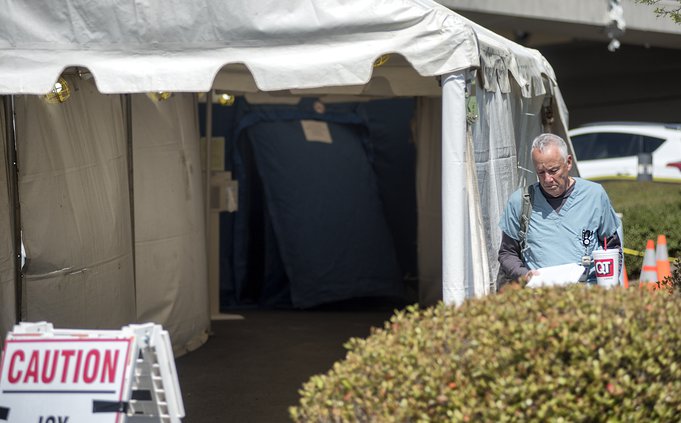We know that you need accurate and up-to-date information about the effects of the coronavirus in the state and our region. The Gainesville Times is making articles directly related to public safety available free to non-subscribers as a public service. Please consider supporting our work by subscribing to The Gainesville Times.
Officials with the Northeast Georgia Health System are encouraging people to keep their distance from each other and signed on to a joint resolution with Hall County and the city of Gainesville Friday to ask people to stay home for 14 days.
Someone infected with the virus infects an average of two to three additional people, and that number can be higher if the person is around a crowd, according to Dr. Supriya Mannepalli, medical director of Northeast Georgia Physicians Group Infectious Disease. And while the elderly are a higher-risk population, the Centers for Disease Control and Prevention reports that people aged 20-44 had the highest percentage of cases, at 29%.
Testing for the virus is being prioritized for:
- Hospitalized patients with respiratory illness of unknown cause, who have signs and symptoms similar to COVID-19
- Health care workers
- Anyone who has come into contact with a confirmed or suspected COVID-19 case or has a history of travel
- Public safety professionals, such as law enforcement, firefighters and emergency medical technicians
- People in illness clusters in a facility or institution such as a school or homeless shelter
- Other high-risk criteria with moderate to severe illness: Age greater than 60 years, presence of chronic medical conditions, or pregnancy. Testing is only done when testing would affect treatment decisions.


Public health officials recommend social distancing, or staying six feet from others, regular hand washing and frequent disinfecting of commonly touched surfaces like doorknobs or countertops.
But Dr. Clifton Hastings, Northeast Georgia Medical Center chief of staff, said outside activities like taking a walk or sitting on the deck are fine, as long as people keep their distance from each other.
“The key is not the fact that you’re in your house. It’s that there’s separation from you and others that may have the disease,” Hastings said.
Dr. Shravan Kethireddy, medical director of critical care at NGMC, said most people who have been infected by the virus will not even show symptoms.


“The canary in the coal mine is when patients end up coming to the hospital. Only 10% of those people being tested right now in the United States, of all people being tested, are actually positive,” Kethireddy said. “And 15% of those end up coming to the ICU. You can imagine, if we’re being overwhelmed by the number of patients coming to the hospital and our ICU is being overwhelmed, you can only imagine the magnitude of the number of people affected in the community.”
The number of people in the community carrying the virus could be 10 times the number of patients being treated, Kethireddy said.
Italy, for example, likely had the virus spreading for weeks before its first confirmed case and its hospital system quickly became overwhelmed, Kethireddy said. Two weeks after the shutdown in Italy, patients are still going to the hospital but rates are plateauing, he said.
“The time to have people stay home is too late when we see the tsunami right in front of us,” Kethireddy said. “I think we still have opportunity to mitigate the impact that this will have, both on the health system and the community, but also on business.”
The system will be receiving support from the Georgia National Guard, who will be helping transport patients and will send a small team within a few days, according to Matthew Crumpton, emergency preparedness manager with NGHS.


NGHS spokesman Sean Couch said the system is deferring questions about testing data to the Georgia Department of Public Health. The system is not releasing information about total tests, outstanding tests or positive tests.
And while the test results can give health care providers an idea of what the virus looks like in their communities, delays in testing and turnaround times for results can cloud the picture.
Michael Covert, NGHS chief operating officer, said turnaround times vary by the lab, but results usually take about three to five days. Covert said those times have improved recently but will likely stay steady for a few weeks.
But Couch said some patients have been waiting for results for more than 10 days after labs were hit with a rush of patient samples around March 15 and 16.
Covert said staffing has not yet been an issue for NGHS at its facilities. The system, like other hospitals, has a need for equipment like gowns, face shields and masks. Use of these materials fluctuates daily, he said.
The system has been able to keep about two to three days’ worth of supplies on hand at a time, Covert said.
The system has about 106 to 109 ventilators available for use, and about 40% to 50% of those are typically in use on a normal cycle, Covert said. But there will be a need during the pandemic, and NGHS has requested about 20 more from the federal government. Covert said the delivery date has not been set yet, and the system is anticipating receiving four or five ventilators from the request.


Mobile units have been installed outside NGMC Gainesville and Braselton. Angela Gary, NGHS director of trauma and emergency services, said they have been used for lower-acuity patients still walking and talking but experiencing some respiratory symptoms. Keeping people with respiratory symptoms out of the emergency department can prevent them from infecting other patients, she said.
The units have been open for about a week, and Gary said the Braselton mobile unit averages about 18 to 20 patients a day while the Gainesville one has been seeing about 20 to 25 patients a day.
Most patients treated at the mobile unit are discharged from there, but Gary said the patients whose cases become more severe go inside to the emergency department.
The ICUs have been fluctuating between 30% and 70% capacity over the past few days, but not all those cases are coronavirus patients, Covert said. Those numbers are typical for the system, he said.
“We’ve not been overwhelmed with that, but we do have COVID-related patients in those facilities,” Covert said.
There are an additional 23 negative pressure treatment spaces in Gainesville and 14 in Braselton. Negative pressure rooms do not allow air to escape the room, preventing airborne contaminants from spreading. Those spaces were previously medical-surgical rooms that were repurposed.
Medical staff leadership are creating protocols to put in place if the hospital reaches capacity.
“We know that the potential exists for us that we could be inundated within a short period of time. We only have so many resources that are available, and so we would then sit with our medical staff leadership to triage our use of those resources,” Covert said. “Everyone would receive care that presents themselves to us, but we have to prioritize the use of those resources. Those are difficult decisions to be made.”

